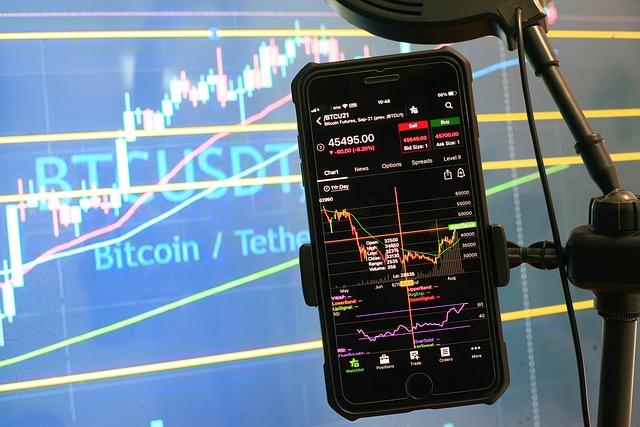Crypto Trading Bot App Guide 2025
Author: Jameson Richman Expert
Published On: 2025-11-07
Prepared by Jameson Richman and our team of experts with over a decade of experience in cryptocurrency and digital asset analysis. Learn more about us.
The rise of automation in crypto markets makes a well-built crypto trading bot app an essential tool for active traders and investors in 2025. This article explains what crypto trading bot apps do, how to choose and set one up, practical strategies, backtesting and risk controls, and the legal and security factors you must consider before letting software trade on your behalf.

What is a crypto trading bot app?
A crypto trading bot app is software that automatically executes buy and sell orders on cryptocurrency exchanges according to pre-defined algorithms, strategies, or machine-learning models. These apps connect to exchange platforms through APIs and can operate 24/7, exploiting market inefficiencies, following trends, or executing systematic strategies that would be difficult for humans to manage manually. For a high-level background on automated trading concepts, see algorithmic trading (Wikipedia).
Why use a crypto trading bot app in 2025?
Several market and technological trends make crypto trading bot apps especially relevant in 2025:
- 24/7 markets: Cryptocurrency markets never sleep, and automated bots capture opportunities at any hour.
- Increased volatility: Volatile price moves create opportunities for algorithmic strategies like scalping, grid trading, and mean reversion.
- Better tools and infrastructure: More exchanges, stronger APIs, institutional-grade data feeds, and improved cloud computing lower the barrier to effective automation.
- AI and signal integration: Bots that incorporate machine learning or real-time signals can adapt to changing market regimes.
For a market outlook that affects strategy selection in 2025, consider current price and forecast commentary such as the Bitcoin price prediction and market outlook for end of February 2025, which helps frame likely volatility and trend scenarios.
Types of crypto trading bot apps
Different bot types suit different goals and risk preferences:
- Trend-following bots: Use moving averages, breakout detection, or momentum indicators to ride sustained moves.
- Grid bots: Place a lattice of buy and sell orders between a price range to profit from oscillating markets.
- Arbitrage bots: Exploit price differences between exchanges or instruments. These require low latency and capital on multiple venues.
- Market-making bots: Provide liquidity by posting both bid and ask quotes around the mid-price to capture spreads.
- Dollar-cost averaging (DCA) bots: Automate periodic buys to reduce the impact of volatility over time.
- Copy-trading / social bots: Mirror strategies from expert traders or a marketplace of strategies.

Key features to look for in a crypto trading bot app
Not all bots are created equal. Prioritize these features when evaluating options:
- Backtesting engine: Historical testing with realistic fees and slippage to validate strategy performance.
- Paper trading: A simulated mode to test live without real capital.
- Multi-exchange support: Ability to run strategies across Binance, Bybit, Bitget, MEXC and others.
- API security and permissions: Granular API key permissions (trade-only, no withdrawals) and IP whitelisting.
- Strategy templates and marketplace: Pre-built strategies and community templates that you can adapt.
- Risk-management tools: Adjustable stop-losses, take-profit, position sizing, and max drawdown thresholds.
- Real-time monitoring & alerts: Mobile and email notifications for fills, errors, and health checks.
- Logging and audit trails: Order histories and performance reports for compliance and improvement.
How to choose the best crypto trading bot app: a practical checklist
- Define objectives: Are you seeking passive income via market-making, capital growth with trend strategies, or reliable accumulation with DCA? The objective drives bot selection.
- Check supported exchanges: Ensure the bot supports your crypto exchange(s). Many traders choose to sign up on major venues; register links: Binance, MEXC, Bitget, Bybit.
- Security posture: Review API handling, encryption, two-factor authentication, and whether the provider stores keys.
- Transparency and reputation: Look for audited code, open-source projects, or vendors with verifiable track records and customer support.
- Costs and fees: Compare SaaS subscriptions, strategy fees, and exchange trading fees for profitability modeling.
- Compliance and legal: Confirm the vendor’s terms of service and your local tax & regulatory obligations.
- Community and education: Active communities and good documentation speed up implementation and troubleshooting.
Setting up a crypto trading bot app: step-by-step
A structured setup reduces errors and prevents costly mistakes:
- Create exchange accounts: Register and verify on preferred exchanges (Binance, Bitget, MEXC, Bybit). Use the referral links above if you plan to open new accounts.
- Enable security features: Activate 2FA (authenticator app or hardware), anti-phishing codes, and email alerts on the exchange account.
- Generate API keys: From the exchange dashboard, create API keys for the bot. Apply permissions conservatively—typically trade enabled, withdrawals disabled, and IP restrictions if offered.
- Test API connectivity: Use the bot’s test utilities or start in paper trading mode to confirm authentication and order handling.
- Backtest strategies: Run backtests with realistic slippage and fees. Validate consistency across different market periods.
- Start small: Deploy with minimal capital and strict risk caps to observe real-market behavior before scaling.
- Monitor and iterate: Regularly review logs, metrics, and update rules as market regimes shift.

Practical strategy examples for a crypto trading bot app
Below are examples with configuration guidance you can adapt and backtest in your bot app. These are educational templates, not financial advice.
1) Simple moving average (SMA) trend-following
Logic: Buy when a short SMA crosses above a long SMA (bullish cross), sell when the short SMA crosses below the long SMA (bearish cross).
- Markets: BTC/USDT, ETH/USDT
- Parameters: SMA_short = 20, SMA_long = 50
- Risk controls: Fixed position size 1–2% of portfolio, stop-loss at 3% below entry, trailing take-profit 6%.
- When to use: Trending markets (confirmed by ADX or volume expansion).
2) Grid trading (range capture)
Logic: Place buy limit orders at set intervals below current price and sell limit orders above, profiting as price oscillates within a defined range.
- Markets: Low-to-medium volatility altcoins or BTC within a range
- Parameters: Range low = 40,000; range high = 44,000; grid lines = 20; grid step = (44k − 40k)/20 = 200
- Risk controls: Capital allocation 10–30% of portfolio per grid; dynamic exit if price breaks out of range beyond 5%.
- When to use: Sideways markets without strong directional momentum.
3) Dollar-Cost Averaging (DCA) bot
Logic: Buy fixed or variable amounts at periodic intervals or when price dips by a percentage. Useful for long-term accumulation.
- Markets: ETH, BTC, major altcoins
- Parameters: Recurring buy every 7 days, purchase value $200 per interval; optional dip-buy: +10% extra buy if price falls 5% since last purchase.
- Risk controls: Total allocation cap, stop additional buys if drawdown exceeds 35% from ATH.
For longer-term price context that may influence DCA decisions, read Ethereum forecasts like Ethereum expected price in 2030 and shorter-term targets such as Ethereum price prediction 2025 (in pounds).
Backtesting and optimizing strategies
Backtesting helps you understand how a strategy would have performed historically; do it carefully to avoid misleading results:
- Use realistic data: Include historical fees, spreads, and slippage. Exchange tick data is preferable to 1-minute OHLC bars for high-frequency strategies.
- Avoid lookahead bias: Ensure your simulation only uses data that would have been available at execution time.
- Out-of-sample testing: Split data into training (in-sample) and testing (out-of-sample) periods to check robustness.
- Cross-validation: Test across different market regimes (bull, bear, sideways) and multiple assets.
- Key metrics to track: Total return, annualized return, max drawdown, Sharpe ratio, Sortino ratio, win rate, profit factor.
Detailed definitions of risk-adjusted metrics such as the Sharpe ratio can be found at reference sources like Sharpe ratio (Wikipedia).
Risk management and security for a crypto trading bot app
Trading bots can magnify both gains and losses. Emphasize security and sensible risk controls:
- Use trade-only API keys: Never enable withdrawal permissions for bot API keys.
- IP whitelisting: Restrict API access to known IP addresses where supported.
- Two-factor authentication: Secure exchange accounts and the bot platform itself with 2FA.
- Position sizing: Limit exposure per trade—1–3% of portfolio is conservative for strategy testing.
- Stop-loss and kill-switches: Configure both per-trade stops and global kill-switch thresholds for drawdown.
- Keep keys encrypted and local: If possible, run self-hosted bots where keys remain under your control rather than relinquishing keys to a cloud vendor.

Costs, fees and ROI expectations
Assess all costs to estimate realistic returns:
- SaaS subscription: Monthly fees for bot platforms can range from free tiers to $50–$300+/month for advanced features.
- Exchange fees: Taker/maker fees, and potential rebates for market-making. High-frequency strategies quickly accumulate fees.
- Slippage and liquidity: Execution quality matters—thin markets increase slippage and reduce profitability.
- Compute and data costs: For self-hosted or machine-learning bots, include cloud compute or data feed expenses.
Remember: historical performance is not a guarantee of future results. For perspective on market-driven returns and long-term price expectations, consult comprehensive price-prediction resources and scenario analyses such as this Cryptocurrency price prediction essential guide.
Legal, tax and compliance considerations
Automated trading does not remove tax and regulatory responsibilities. Important considerations:
- Tax reporting: Many jurisdictions treat cryptocurrency gains as taxable events. See the IRS virtual currencies tax FAQ for U.S. guidance. If you are in the UK, HMRC provides guidance on crypto transactions.
- Regulatory licenses: If you provide a bot service or signal subscription, you may need to comply with financial regulations in certain jurisdictions.
- Recordkeeping: Keep detailed records of bot trades, P&L, and API activity for auditing and tax reporting.
- Legal advice: Consult a qualified tax advisor and legal counsel for jurisdiction-specific obligations.
Common mistakes and how to avoid them
Beginner mistakes are often responsible for avoidable losses. Watch for these pitfalls:
- Overfitting strategies: Tweaking parameters to perfectly fit historical data (curve-fitting) leads to poor live performance. Use robust out-of-sample testing.
- Ignoring latency and slippage: Assume some slippage and model it into backtests.
- Excess leverage: High leverage amplifies risk—limit use until strategies are proven live.
- Poor key security: Leaving withdrawal permissions enabled or storing keys in plain text invites theft.
- Neglecting monitoring: Bots can encounter execution errors, API outages, or account issues; set up alerts and daily checks.

Deployment options: cloud vs self-hosted
Choose a deployment model based on comfort with technical operations and security:
- Cloud/SaaS platforms: Easier to set up, often offer UIs, strategy marketplaces, and managed infrastructure. Consider vendor reputation and data handling policies.
- Self-hosted solutions: Greater control over API keys and environment; requires technical skills to deploy and maintain (server, security, backups).
Integrating signals and market research
Trend, sentiment, and fundamental signals can improve bot performance when combined intelligently:
- On-chain metrics: Active addresses, exchange inflows/outflows, and staking statistics can inform macro timing.
- Macro and news feeds: High-impact events (ETF approvals, regulatory announcements) can be captured with news-based risk-off gates.
- Third-party signals: Some bots can subscribe to signal providers; validate signal performance via independent backtesting before paying for subscriptions.
For curated market predictions and scenarios that can help shape signal assumptions, read forecasting work such as this Bitcoin price prediction and market outlook and the Ethereum forecasts linked earlier.
Examples of monitoring and reporting you should implement
- Trade logs: Time, market, side, size, price, and reason (signal) for each fill.
- Performance dashboard: P&L by strategy, open P&L, realized/unrealized returns, drawdown curve.
- Alerting: Email/SMS/push alerts for critical thresholds (e.g., server down, API key invalid, drawdown breaches).
- Reconciliation: Regularly reconcile bot records with exchange statements to detect discrepancies.

Emerging trends in crypto trading bot apps for 2025 and beyond
Expect these developments to shape the bot landscape:
- AI-native strategies: More bots will integrate large language models and reinforcement learning to adapt to market shifts.
- Cross-chain automation: Bots that operate across DEXs and CEXs bridging liquidity and arbitrage opportunities.
- Institutional-grade tooling: Execution algorithms, smart order routing, and best-execution analytics will become more common.
- Regulatory scrutiny: As automated strategies become larger, compliance features and auditability will be increasingly required.
Long-term market scenarios influence which of these trends make sense to adopt. For instance, long-range price and adoption forecasts like Ethereum expected price in 2030 inform strategic decisions for accumulation bots and long-term hedging.
Case study: Launching a conservative bot portfolio
Example: An investor wishes to allocate $50,000 into automated strategies across BTC and ETH with conservative risk.
- Allocation: 50% BTC strategies (trend + grid), 40% ETH strategies (DCA + trend), 10% stablecoin for fees and liquidity.
- Risk rules: Max position size 3% of portfolio, total exposure cap 60%, global stop-loss across strategies at 20% drawdown.
- Implementation: Use a multi-exchange bot with Binance and Bitget accounts (register via the links above). Start grid bots on BTC with narrow ranges after backtesting; deploy weekly DCA on ETH informed by long-term forecasts (see ETH 2025 price analysis).
- Monitoring: Daily health checks, weekly performance reviews, monthly parameter re-optimization based on new market data.
Where to learn more and find strategy ideas
Use a combination of educational resources, community forums, and research papers:
- Cryptocurrency (Wikipedia) — basics and taxonomy of digital assets.
- Algorithmic trading primer (Investopedia) — core concepts and strategy types.
- Exchange docs — read Binance, Bybit, Bitget and MEXC API documentation to understand rate limits and order types.
- Strategy repositories and open-source bots — study implementations to learn best practices before coding your own.

Final checklist before you deploy a live crypto trading bot app
- Backtested strategy across multiple regimes with out-of-sample testing.
- Paper trading validation completed and stable.
- API keys created with trade-only permission and IP whitelisting.
- Position sizing and global risk limits set, including kill-switch.
- Monitoring, alerting, and reconciliation processes in place.
- Tax and regulatory obligations understood for your jurisdiction.
Conclusion
A quality crypto trading bot app can improve execution, reduce emotional errors, and systematically capture opportunities in volatile markets if built and managed responsibly. Choose software with robust backtesting, strong security, and transparent operations; treat bot deployment like an engineering project—iterate, monitor, and control risk. For market context and scenario planning that can help shape your bot strategies, consult price outlooks and guides like this Cryptocurrency price prediction essential guide, the Bitcoin 2025 outlook, and Ethereum forecasts at Ethereum expected price in 2030 and Ethereum 2025 in GBP.
If you are opening exchange accounts to begin testing, you can register here: Binance, MEXC, Bitget, Bybit.
Important: This article is educational and not financial or tax advice. Consult licensed professionals before investing or deploying capital. Continuous monitoring, disciplined risk management, and realistic expectations are the keys to successful automated crypto trading in 2025.